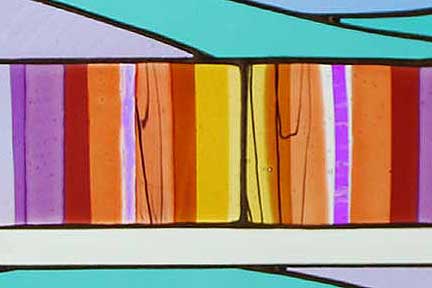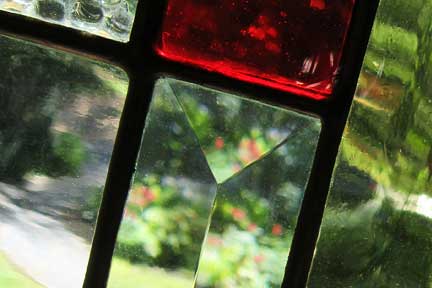Stained glass allows nature to play with art on its own terms
|
Ingredient No. 1
Light
All colors depend on light. It bends, reflects and disperses into a wide spectrum of wavelengths, illuminating the world around us, making possible our sense of sight.
|
Ingredient No. 2
Design
Design expresses the process of developing a path to construction for a desired outcome. Sometimes thought through in its entirety, many times left to the direction of the moment.
|
Ingredient No. 3
Craft
The faculty of executing well what one has devised to achieve. The use of skill and experience to shape materials and bring out the highest of their qualities.
|
|
Light streaming through the hanging window panel onto the window sill.
|
Combining new and ancient techniques with contemporary imagesThe process of stained glass dates to medieval times, and involves using various metals to hold together individually hand-cut pieces of glass.
I have enjoyed incorporating other elements--sheets of copper, brass or nickel silver, copper tubing, glass rods, low fire hand-painting and kiln-fired glass, creating my own unique approach to this art form. My background in painting (BFA 1979 VCU) and my love of nature drew me to glass over 40 years ago. It interacts with its environment, and changes with the light of day and night. It has a unique ability to invoke a sense of place, the quality of light on a landscape, or the state of mind one brings to these things. - Janet Smith |
Each one is handmade and unique
UNIQUE MATERIALS
Dichroic Glass
Dichroic glass is produced by stacking layers of opaque black or clear glass with microlayers of metals and oxides. This causes the color of the glass to shift dependent upon viewing angle. Clear dichroic glass will transmit one color through itself, while reflecting a different second color.
|
"My pieces are an ever changing interaction of light and glass."
Janet Smith - Light Images Glass
Stained Glass Artworks created by Janet Smith, Light Images Glass












